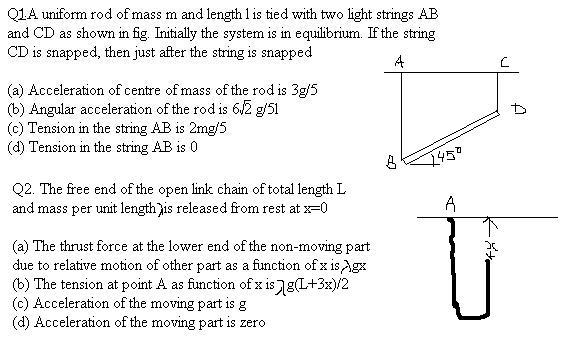Q1) Just after the thread CD is cut, let the tension in the thread AB be T. Taking the torque about the center of the rod, we get T\sin45^\circ \dfrac{\ell}{2}= \dfrac{1}{12}m\ell^2\beta
where β is the angular acceleration of the rod. This gives
T=\dfrac{m\ell\beta}{3\sqrt{2}} ------ (1)
Along the vertical direction, we get
mg-T=ma_c -------- (2)
Now, the acceleration of the point of the rod which is tied to the thread must have zero acceleration along the thread, so we get
a_c=\beta\dfrac{\ell}{2}\cos45^\circ=\dfrac{\beta\ell}{2\sqrt{2}} ------- (3)
So we get from (2)
mg-\dfrac{m\ell\beta}{3\sqrt{2}}=ma_c
And using (3), the last equation gives
a_c=\dfrac{3}{5}g
And from (3), we get
\beta =\dfrac{6\sqrt{2}}{5}\dfrac{g}{\ell}
And finally we get the tension as
T=\dfrac{2}{5}mg
3 Answers
kaymant
·2010-02-06 07:52:09
Asish Mahapatra
·2010-02-07 07:17:19
Sir,
wont the point B remain at rest. ? (or will it have some accleration)
kaymant
·2010-02-09 19:48:57
Well, it will be at rest initially. But it would still have an acceleration. In fact, it is going to move in a circle. So it would have a centripetal acceleration towards A and a tangential acceleration. However, initially its velocity is zero, that's why I put the centripetal acceleration (i.e. the acceleration along the thread) to zero (equation (3)) in my last post. But it would still have a tangential acceleration which you could use to determine, for example, the initial angular acceleration of the thread AB.
